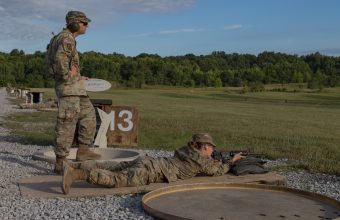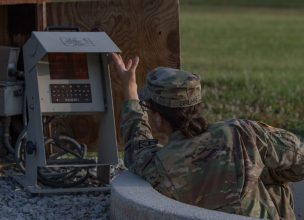FORT KNOX, Ky. — The sound of gun fire boomed across George Blair Range on July 14 while 9th Regiment, Advanced Camp, Cadets completed their Weapons Qualification.
Cadets had three days to prepare for weapons qualification. Those three days included: Preliminary Marksmanship Instruction (PMI), Group and Zero and Down Range Feedback.

Cadet Michelle Demarais, from Austin Peay University, aims her weapon down range while a Cadre member observes during weapons qualification on July 14 at Fort Knox, Kentucky. To qualify with a weapon, Cadets must shoot at least 23 of 40 pop-up targets. | Photo by Reagan Zimmerman, CST Public Affairs Office
At PMI, Cadets learned about the fundamentals of their weapons systems in a classroom setting. On the second day, Cadets took to a range to learn how to group and zero their weapons. Cadets refined their skills on the third day in preparation for the qualification the next morning.
Last year, Cadets had two days of weapons training but this year, Cadet Command extended the training by two days in hopes of improving Cadets marksmanship skills.
University of Wisconsin-Madison Professor of Military Science and Cadet Summer Training Basic Rifle Marksmanship (BRM) Commanding Chief, Lt. Col. Scott Cheney, believes that practice is the key to success on the range.

Cadet Natalie Bruhn, from the University of Richmond, peeks at her score after completing weapons qualification on July 14 at Fort Knox, Kentucky. To qualify with a weapon, Cadets must shoot at least 23 of 40 pop-up targets. | Photo by Reagan Zimmerman, CST Public Affairs Office
“The more time they have behind the weapon system, the better off they are going to be,” Cheney said.
With the addition of the two training days, Cadre are seeing a change.
“To put it in perspective, last year, when they came out here and did this range, 49 percent of them qualified [on the] first time with 23 or higher,” Cheney said. “This year, we had about 65 percent or higher qualify [on the] first time. We have seen a significant change.”
Repetition is Key
Cadre are not the only ones seeing a difference.

A Cadet from 9th Regiment, Advanced Camp, lets a shell casing fly during weapons qualification on July 14 at Fort Knox, Kentucky. To qualify with a weapon, Cadets must shoot at least 23 of 40 pop-up targets. | Photo by Reagan Zimmerman, CST Public Affairs Office
For Oregon State University Cadet Sean Hudson, and originally from Louisville, Kentucky, the extra training helped him qualify.
“For me, I understand the fundamentals intellectually, it’s just a matter of getting the repetition and getting experience with it. So, every extra minute of shooting helps. I would say, the extra days helped.”
Hudson saw a difference from his last qualification.
“Before this, the last time I tried to qualify on a pop-up range, I literally got 5 out of 40, but this time, I got 28 out of 40. That is still not great but it is for sure better than it was before.”
Rifleman First
“Our job is to fight and win our nation’s wars which means we have to destroy the enemy,” Cheney said. “[In the future], you could find yourself in a scenario where you are in close-quarters-combat with an enemy. So, lethality is a huge part of the United States Army, it is kind of our bread and butter.”

Cadets from 9th Regiment, Advanced Camp, complete weapons qualification on July 14 at Fort Knox, Kentucky. To qualify with a weapon, Cadets must shoot at least 23 of 40 pop-up targets. | Photo by Reagan Zimmerman, CST Public Affairs Office
The increase in success is important to Cadets and Cadre because basic marksmanship is crucial for the Army.
“[Weapons qualification] ensures that everyone, regardless of branch, male or female, private or general, has to be able to shoot and engage the enemy. Everyone is a rifleman first and your branch comes after that.”




